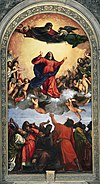Wikipedia:Sandbox: Difference between revisions
No edit summary |
No edit summary |
||
| Line 15: | Line 15: | ||
The Atelier of [[Léon Bonnat]] (1846-1855), one of the more liberal instructors, stressed simplicity in art above high academic finish, as well as overall effect rather than detail. Bonnat's students exhibited a wide range of styles and included : [[Gustave]] [[Caillebotte]], [[Suzor-Coté]], [[Georges Braque]], [[Thomas Eakins]], [[Raoul Dufy]], [[Marius Vasselon]], [[Fred Barnard]], [[Aloysius O'Kelly]], and [[Henri de Toulouse-Lautrec]].[2] |
The Atelier of [[Léon Bonnat]] (1846-1855), one of the more liberal instructors, stressed simplicity in art above high academic finish, as well as overall effect rather than detail. Bonnat's students exhibited a wide range of styles and included : [[Gustave]] [[Caillebotte]], [[Suzor-Coté]], [[Georges Braque]], [[Thomas Eakins]], [[Raoul Dufy]], [[Marius Vasselon]], [[Fred Barnard]], [[Aloysius O'Kelly]], and [[Henri de Toulouse-Lautrec]].[2] |
||
[[Image:Tizian 041.jpg|right|thumb| |
[[Image:Tizian 041.jpg|right|thumb|100px|Titian (1516–1518)]] |
||
Although individual students study a wide range of old masters, many study the painting techniques and compositional skills of the High Renaissance, Mannerist and Baroque styles, including Michelangelo, Raphael and Leonardo da Vinci, Titian, Rubens, El Greco. |
Although individual students study a wide range of old masters, many study the painting techniques and compositional skills of the High Renaissance, Mannerist and Baroque styles, including Michelangelo, Raphael and Leonardo da Vinci, Titian, Rubens, El Greco. |
||
Revision as of 21:17, 6 September 2009
Welcome to this sandbox page, a space to experiment with editing.
You can either edit the source code ("Edit source" tab above) or use VisualEditor ("Edit" tab above). Click the "Publish changes" button when finished. You can click "Show preview" to see a preview of your edits, or "Show changes" to see what you have changed. Anyone can edit this page and it is automatically cleared regularly (anything you write will not remain indefinitely). Click here to reset the sandbox. You can access your personal sandbox by clicking here, or using the "Sandbox" link in the top right.Creating an account gives you access to a personal sandbox, among other benefits. Do NOT, under any circumstances, place promotional, copyrighted, offensive, or libelous content in sandbox pages. Doing so WILL get you blocked from editing. For more info about sandboxes, see Wikipedia:About the sandbox and Help:My sandbox. New to Wikipedia? See the contributing to Wikipedia page or our tutorial. Questions? Try the Teahouse! |

An Atelier Method is a method of fine art instruction modeled after the private art studio schools of 15th to 19th century Europe. Taking its name from the French word for "artist's studio," the Atelier Method is a form of private instruction in which an artist, usually a professional painter, works closely with a small number of students to progressively train them. Atelier schools can be found around the world, particularly in North America and Western Europe.
Although the methods vary, most painting studios train students in the skills and techniques associated with the creation of representational art, creating two-dimensional images that appear real to the viewer and traditionally include sessions for drawing or painting a nude model.
Sight-Size Method
Ateliers emphasizing the sight-size method generally agree that the practice of careful drawing is the basis of painting. Charles H. Cecil, founder of Charles H. Cecil Studios, an atelier located in Florence Italy writes:

The Atelier of Léon Bonnat (1846-1855), one of the more liberal instructors, stressed simplicity in art above high academic finish, as well as overall effect rather than detail. Bonnat's students exhibited a wide range of styles and included : Gustave Caillebotte, Suzor-Coté, Georges Braque, Thomas Eakins, Raoul Dufy, Marius Vasselon, Fred Barnard, Aloysius O'Kelly, and Henri de Toulouse-Lautrec.[2]

Although individual students study a wide range of old masters, many study the painting techniques and compositional skills of the High Renaissance, Mannerist and Baroque styles, including Michelangelo, Raphael and Leonardo da Vinci, Titian, Rubens, El Greco.
- ^ Mims Studios School of Fine Art", mimsstudios.com. Retrieved 7 September 2008.

